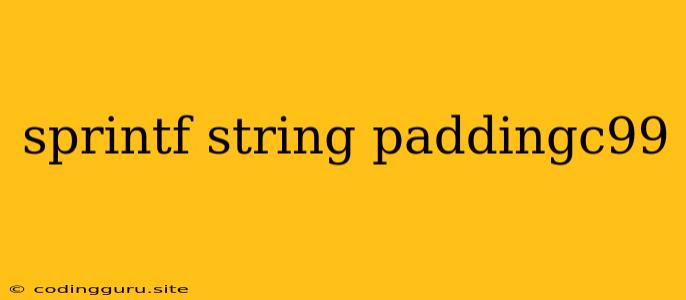Mastering String Padding in C99 with sprintf
String padding is a common task in programming, especially when dealing with formatted output. It involves adding spaces or other characters to a string to achieve a desired length or alignment. In C99, the sprintf function offers powerful features for string padding, enabling you to precisely control the formatting of your output.
Understanding String Padding
Before diving into the sprintf function, let's understand the basics of string padding. Imagine you have a list of numbers, and you want to display them neatly in a table with each number aligned to the right. This requires padding the shorter numbers with spaces to match the length of the longest number.
The Power of sprintf
The sprintf function, a versatile tool in the C standard library, allows you to format strings and store the result in a character array. It provides special format specifiers to control the output, including options for padding.
The % Specifier
The % specifier is the key to formatting in sprintf. It tells the function how to interpret the arguments and how to format the output. For example, %d indicates an integer, %s represents a string, and %f formats a floating-point number.
Padding with % Specifier
The % specifier can be extended with modifiers to achieve padding. Here's the general syntax:
%[flags][width][.precision][length]specifier
Width Specifier: The width modifier controls the minimum field width. If the argument's length is less than the specified width, the output will be padded with spaces or zeros to reach the desired length.
Example:
char buffer[100];
int number = 12;
sprintf(buffer, "%5d", number); // Pad with spaces to a width of 5
printf("%s\n", buffer); // Output: " 12"
Padding with Spaces and Zeros:
- Spaces: By default,
sprintfpads with spaces. - Zeros: To pad with leading zeros, use the
0flag:
sprintf(buffer, "%05d", number); // Pad with leading zeros to a width of 5
printf("%s\n", buffer); // Output: "00012"
Padding Strings and Other Data Types
String padding is not limited to numbers. You can apply it to any data type you can format with sprintf.
Example: Padding Strings
char name[50] = "Alice";
sprintf(buffer, "%-10s", name); // Left-align the string with spaces padding to 10
printf("%s\n", buffer); // Output: "Alice "
Example: Padding Floating-Point Numbers
float price = 19.99;
sprintf(buffer, "%8.2f", price); // Pad with spaces to a width of 8 and 2 decimal places
printf("%s\n", buffer); // Output: " 19.99"
Advanced Padding Techniques
Left-Alignment and Right-Alignment:
-: This flag left-aligns the output within the specified width.- Without
-: The output is right-aligned by default.
Precision:
.precision: The precision modifier controls the number of digits after the decimal point for floating-point numbers. It also defines the maximum number of characters for strings.
Best Practices and Tips
- Memory Management: Always ensure that the
bufferis large enough to hold the formatted string. - Error Handling: Check the return value of
sprintfto detect potential errors, such as buffer overflow. - Clarity and Consistency: Use consistent formatting and padding throughout your code for better readability.
Conclusion
sprintf is a powerful function in C99 that provides excellent control over string formatting, including padding. By mastering its syntax and features, you can achieve cleaner and more readable output, enhancing your code's quality and maintainability.
